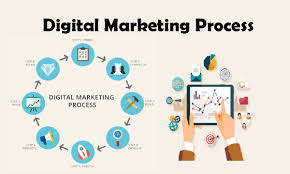The Basics of Digital Advertising
Digital advertising has become an essential component of modern marketing strategies. Understanding how digital advertising works can help businesses effectively reach their target audience and achieve their marketing goals.
What is Digital Advertising?
Digital advertising refers to the practice of promoting products or services using online platforms, such as websites, social media, search engines, and mobile apps. Unlike traditional forms of advertising, digital advertising allows businesses to target specific demographics, track performance metrics in real-time, and adjust campaigns accordingly.
Types of Digital Advertising
There are various types of digital advertising, including:
- Display Ads: These are visual ads that appear on websites and mobile apps. They can be in the form of banners, pop-ups, or interstitial ads.
- Search Engine Marketing (SEM): This involves placing ads on search engine results pages based on specific keywords.
- Social Media Advertising: Ads displayed on social media platforms like Facebook, Instagram, Twitter, and LinkedIn to reach a targeted audience.
- Video Advertising: Video ads that appear before or during online video content on platforms like YouTube.
- Email Marketing: Promotional emails sent to a targeted list of recipients to promote products or services.
The Benefits of Digital Advertising
Digital advertising offers several benefits for businesses, including:
- Targeted Reach: Businesses can target specific demographics based on factors like age, location, interests, and online behaviour.
- Measurable Results: Performance metrics such as clicks, conversions, and engagement rates can be tracked in real-time to evaluate the effectiveness of campaigns.
- Cost-Effective: Digital advertising often provides a better return on investment compared to traditional forms of advertising due to its ability to target specific audiences more effectively.
- Flexible Campaigns: Campaigns can be easily adjusted based on real-time data and insights to maximise results.
In Conclusion
In today’s digital age, understanding digital advertising is crucial for businesses looking to expand their online presence and reach potential customers. By leveraging the power of digital advertising channels effectively, businesses can create targeted campaigns that drive engagement and increase brand awareness.
Understanding Digital Advertising: Answers to Common Questions
- What is digital advertising and how does it work?
- What are the different types of digital advertising channels available?
- How can businesses target specific audiences through digital advertising?
- What are the key benefits of using digital advertising for marketing?
- How can businesses measure the effectiveness of their digital advertising campaigns?
What is digital advertising and how does it work?
Digital advertising is a strategic marketing approach that utilises online platforms to promote products or services to a targeted audience. It encompasses various forms such as display ads, search engine marketing, social media advertising, video ads, and email marketing. Digital advertising works by businesses creating ad campaigns tailored to specific demographics and interests, reaching potential customers through channels like websites, social media platforms, search engines, and mobile apps. By leveraging data analytics and targeting tools, businesses can track the performance of their ads in real-time, measure key metrics such as impressions and conversions, and optimise campaigns for maximum effectiveness.
What are the different types of digital advertising channels available?
One frequently asked question regarding understanding digital advertising is, “What are the different types of digital advertising channels available?” Digital advertising encompasses a variety of channels through which businesses can promote their products or services online. Some common types of digital advertising channels include display ads on websites and mobile apps, search engine marketing (SEM) through targeted keywords, social media advertising on platforms like Facebook and Instagram, video advertising on platforms such as YouTube, and email marketing campaigns to reach a targeted audience. Each channel offers unique opportunities for businesses to connect with their target audience and drive engagement effectively in the digital landscape.
How can businesses target specific audiences through digital advertising?
Businesses can target specific audiences through digital advertising by utilising advanced targeting tools and techniques available on various online platforms. One common method is demographic targeting, which allows businesses to focus their ads based on factors such as age, gender, location, and interests. Behavioural targeting is another effective strategy that involves tailoring ads to individuals based on their online behaviour and interactions. Moreover, businesses can utilise retargeting tactics to reach users who have previously engaged with their website or shown interest in their products or services. By combining these targeting methods with data analytics and audience segmentation, businesses can create highly targeted digital advertising campaigns that resonate with their desired audience and drive better results.
What are the key benefits of using digital advertising for marketing?
One of the frequently asked questions regarding understanding digital advertising is, “What are the key benefits of using digital advertising for marketing?” Digital advertising offers businesses a multitude of advantages, including targeted reach, measurable results, cost-effectiveness, and flexible campaign strategies. By leveraging digital advertising platforms, businesses can precisely target their desired demographics based on various factors such as age, location, interests, and online behaviour. The ability to track performance metrics in real-time allows businesses to evaluate the effectiveness of their campaigns and make data-driven decisions to optimise results. Moreover, digital advertising often provides a higher return on investment compared to traditional forms of marketing due to its cost-effectiveness and the ability to adjust campaigns quickly based on real-time insights. Overall, utilising digital advertising in marketing strategies enables businesses to reach their target audience effectively and drive engagement while maximising brand awareness in the competitive online landscape.
How can businesses measure the effectiveness of their digital advertising campaigns?
Businesses can measure the effectiveness of their digital advertising campaigns through a variety of key performance indicators (KPIs) that provide valuable insights into campaign success. Metrics such as click-through rates, conversion rates, cost per acquisition, return on ad spend, and engagement levels help businesses evaluate the impact of their campaigns on target audiences. By analysing these metrics in real-time and comparing them against predefined goals, businesses can assess the ROI of their digital advertising efforts and make data-driven decisions to optimise future campaigns for better results.




